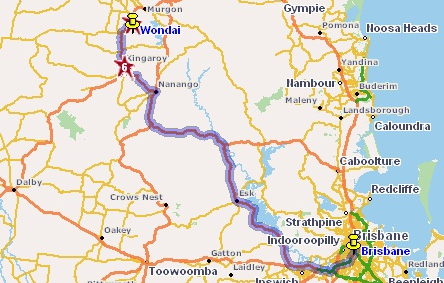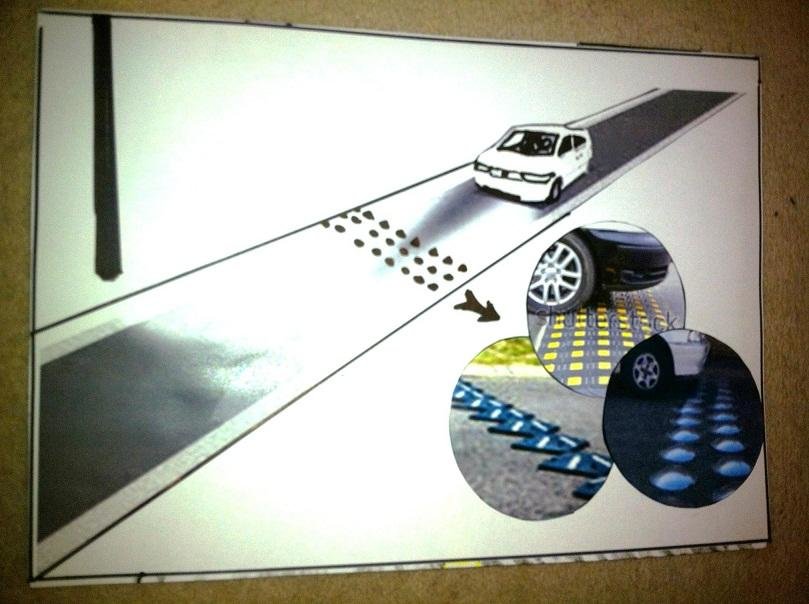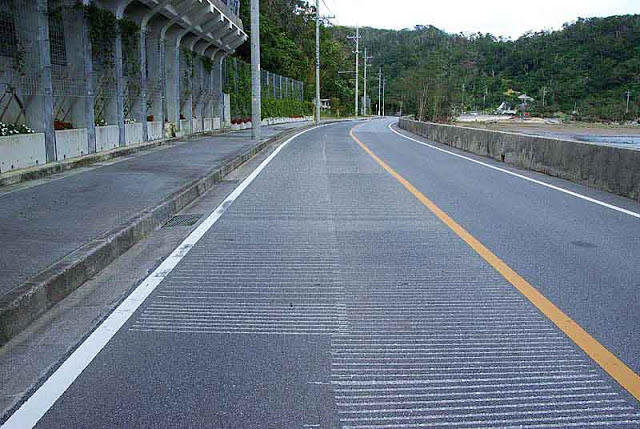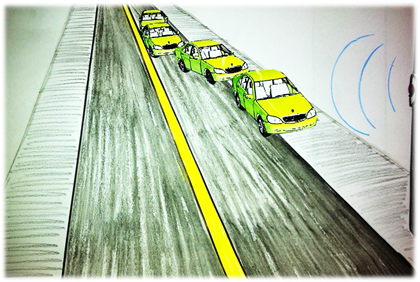Introduction
There are various methods that have been applied to save lives in road accidents. This is evident in the transport system especially involving drunk drivers (Hjelmeland, Beckelman & Wynne 1990). In Japan, some viable methods have been applied successfully to protect life. The strategies applied will be discussed in the following paragraphs. These methods can be implemented to enhance transport safety.
The Chosen Location
The Bunya Mountains Road is an upcountry road that plays a vital role in the country. The road covers one hundred and seventy three kilometers. It goes from near Kaimkillenbun to near Kumbia. It is situated in Queensland and connected with Bunya highway which links Warrego to the main highway of Burnett. It comes close to Bunya mountain national park.
The road covers various places with different safety requirements. The road near the national part is associated with increased users due to the high number of tourists visiting the national park.
However, the mountainous section is zigzag to allow movements towards the top. There are several urban areas along the stretch. This road was chosen because it offered room for modification. In addition, it has a dynamic landscape that would provoke innovation.
Concept Development

My concept is how design can keeps electricity poles safer on the roadside by using different methods. These methods are illustrated and described in the following paragraphs.

Road Bumps
Road bumps are structures that have been constructed to regulate speeding vehicles. It plays a fundamental role of demanding that a model should help in speed regulation and traffic management. A scientific tool applied is the mathematical concept of Fourier series. It is through the analysis of the vehicle movement where it was observed that the movement can be represented in the form of sinusoidal pattern (Lerner 2011).
A further study reveals that auxiliary equation is developed. Additionally, a root is used in structuring these bumps that slow vehicles down. This equation is characterized by having both the complementary aspects and particulate aspects. The roots that are obtained from solving the auxiliary equations take various forms.
They may be real and equal, complex and conjugate, or real and distinct. Each combination explains a different phenomenon that will help to determine how the bumps will be structured and spaced. In addition, this will imply that oscillation motion cannot be realized when the solution to auxiliary motion is complimentary notwithstanding the condition outlined earlier.
The suspension system of a locomotive is meant to provide safety and comfort. When the car encounters irregular surface on the road, its suspension system is altered. In the car, various components of the suspension system absorb these vibrations.
This, then, helps in reducing the speed of the car to a low level. Mathematical equations on auxiliary have been used to develop the appropriate distance between two bumps. This equation aids in determining the minimal speed limit. This is achieved through influencing transition ratio that exists between the suspension system of the vehicle and the road surface.
A drunk driver will benefit from a road with bumps due to cyclic causes of discomfort. After some time, the auxiliary equation defines that there will be bumps that will cause a particulate level of discomfort to the drunk driver (Knox 1988). This will help to keep him up and attract a considerable high level of concentration.
This will reduce chances of causing and accident. This will be the case since bumps will help to reinforce the speed limit regulation. However, bumps will have mere help on superhighways since they are designed to regulate speed where sinusoidal motion is applicable. This can be achieved in a rural setup due to short distances coverage.
Japan has applied bumps in most of the residential streets. This was meant to ensure that motorist use the streets at the recommended speed as outlined by the road regulation authorities. The Japanese have applied extensive scientific reasoning in their bump models that include distance between them, their shapes and their characteristics. The designs of their bumps consider their size, width and height extensively.
In most cases, width of the road is similar to the length of the bump that leads to entire road coverage. This scientific backed reasoning is effective and strategic in enhancing road safety especially for drunk drivers. This reasoning is applicable for upcountry roads where residential and populated areas are concerned.
Lighting

There are various aspects of lighting that should be considered in reducing accidents caused by drunk driving. IL luminance is one of the factors that will aid in reducing the accidents. This helps to elaborate the area that is covered with light. This ensures that all the light is distributed evenly throughout the road. Color rendering refers to the ability of lighting when revealing items effectively in their real and actual color.
This will help in maintaining familiarity with the object since the driver regularly uses the road. Otherwise, the driver will fail to identify the features that he is acquainted with on that piece of road. Color temperature is another vital element that serves in upholding road safety.
This concept relates to the comparison of lamp appearance as compared to the appearance of a standard tungsten lamp. The height of poles will ensure uniform lighting system.
Luminance involves the reflection light rays striking on the road surface towards the driver’s direction. Therefore, the road must be capacitated to reflect light and determine the amount of light to be reflected. This is meant to ensure that the light is enough to help the driver see the road hence avoiding a situation where light is an abstracting factor.
Lighting the surrounding will help in the objective of reducing the accidents. Drivers are given the opportunity to see the stationary objects that are present along the carriageway. This helps in identifying new features that may have been developed without the knowledge of the driver.
To support the importance of background lighting, observation is considered vital and effective. It is known and proven that an eye can adapt to various intensities of light ranging from moonlight to sunlight. It aligns with the concept that drunk drivers can view the road. This option is practical in upcountry roads.
Japanese roads have a fundamental character that dissociates them from other roads. This lies in their systematic lighting meant for the drivers. They have developed a cost effective system that they are using to light up their road as well as their surroundings. The lights are cost effective due to their power saving abilities. A good example is the Japanese road tunnels where the lighting system is rated among the best in the world.
Sound Alerts
Sound alerts are applicable on the highways. The sound alerts ensure that the driver is awake and alert when driving. The sound alerts are comprised of designed musics that help to keep the drunk drivers awake and reduce the number of accidents in the upcountry highway. In Okinawa, there is a credible example where the highway has music systems to keep drivers alert and prevent accidents.
In achieving credible results, there are several techniques that can be combined to facilitate concentration. Fatigue Monitor Evaluation could be employed to ensure that the driver is concentrating on driving. The three monitors will keep trace of eye closing, head nodding and reaction time. The alarm is triggered to alert everyone when the evaluation detects that the driver’s head is acting abnormally.
In other instances, activities of the driver’s eyes are monitored. For instance, if a driver’s eyes are not blinking, the eye monitor triggers the system to raise an alarm. In case the response time is long, the system is connected to the breaking system to stop the vehicle. The highway system will be programmed to apply sound alert signals and inform the a uthorities.


Ditch Japanese roads are designed to safeguard the utility poles against the atrocities caused by drunk drivers. The ditch is not dangerous due to its small depression. This depression can restrain a car from hitting the utility poles. Upcountry roads could be made to include a ditch between the road and utility posts. In addition, poles could be strong to restrain a vehicle from causing damages.
Additionally, the poles minimize the damage caused to the car. However, balance should be considered when designing poles. For instance, the strength of poles should not be too high due to impact effects. This could minimize the death risks arising due to sudden braking. The poles will be well spaced to reduce cost and establish the practical distance that could enhance the primary purpose.
Japanese roads are wide to enhance safety. Japanese road safety strategies have allowed the country to realize a 70% reduction of its road carnage. This is facilitated by the wide road area provided to drivers for movement management. For instance, staggering of vehicles must be considered to prevent collisions.
This implies that the driver has few chances of exiting from the road. In addition, when the vehicle gets to the road, the speed will not be fast enough to pass the ditch. This will enhance minimization of damages and deaths.


Wi-Fi
Wi-Fi technology could be applied to determine activities of drivers when driving. This will be actualized through the combination of driver’s roles and the highway’s design. Wi-Fi will depend on the usage of internet to achieve the desired link between the car and the highway facility. This will save lives of many drunk drivers and safeguard the highway facilities from being damaged by the drivers.
The cars will be fitted with internet-enabled devices that apply Global Positioning System technology. A similar gadget will be installed on the utility poles that are on the roadside. Internet connection will be used to establish the required connection between the gadgets that are fitted in the car and the utility poles (Blocker, Fahey & Tyrrell 2003).
Drunk drivers have the tendency of inconsistencies driving that causes them to veer of the road or cross to the wrong lane in case of single lane road. The role of the device is to ensure that the distance between pole and cars is not less than five meters.
The five-meter regulation is meant to prevent the car from hitting the pole. This will be archived through monitoring the car distance from the pole. Once the driver veers off the road towards the utility poles, the gadget will detect reducing distance.
When the vehicle crosses the five meters mark, the gadget triggers it to break. Consequently, the system manages to save the driver and the pole. This process will be repeated twice before informing the authority about the impending hazard.
Safe-T-Cam System has been applied in monitoring movement of heavy commercial vehicle. This is used to counter excessive driving hours and speeding. In upcountry roads, this system can be applied to regulate a drunk driver speeding tendencies (Evans 1991).
This system can be advanced to allow internet usage through the Wi-Fi to regulate and update the driver, and if necessary the authorities, of his speeding hence triggering response process.
The use of WIFI in Japanese road is a living reality. Their enhancement in road safety has been technologically propagated coupled by their vibrant innovation skills. WIFI is another line of technology that they have utilized successfully to save lives.

Bunya Highway Images
The road is fitted with lighting system and other utility poles. In this case, the developers will ensure that they fit Wi-Fi enabled devices. This will result to a little alteration of the poles to fit in the devices. The road has no ditch along its side. It will be necessary to create a ditch along the road stretch. This will help to protect the utility poles from damage by the drunk drivers.
The bumps will be constructed in the urban areas and along the stretch of the road with considerably large number of residents. Bumps are, also, constructed in the area covering the national park due to increased motorist and human activities. This will help to slow down the drunk drivers and protect them from dying. The sound alert system will be fitted in the utility poles.
An appealing music is used to keep people and drivers active. The Wi-Fi and system alert should be connected to inform the authorities about unsafe driving activities. These could include more than one intervention from Global Positioning System (GPS) technology and frequent triggering of alert sounds.
The zigzag part of the road should have deeper ditches that have the capacity to stop the vehicle. These ditches are designed to ensure that vehicles move at a low speed.
Proportion of crash that involves utility poles against fixed objects.

Maps of Australian Upcountry Roads
The following list contains some roads of Australian upcountry.
- Goulburn valley freeway.
- Gore highway.
- New England highway.
- Roe Highway Midvale.
- Great Northern Highway.
- Brooker Highway.
- Midland Highway.
- Bass Highway.
Conclusion
Road accidents require attention of drivers to reduce cases of death. These accidents have been addressed by the government due to their fatal repercussions. Consequently, the method that was outlined has dictated all these issues in an explicit manner. Application of these strategies must be enforced to ensure that people do not break the rules.
Otherwise, breaking the traffic rules will continue to cause deaths. Pedestrians and passengers should be cautious about driving and driving behavior. Reinforcing scientific strategies with logical finding will lead to reduction of accidents. Therefore, it is vital to apply these techniques strategically and determine their influences to the society. Protecting people is a vital section that transport systems cannot afford to avoid.
References
Blocker, J, Fahey, D, & Tyrrell, I 2003, Alcohol and temperance in modern history: an international encyclopedia, ABC-CLIO. Santa Barbara, Calif.
Burnett South’s Up Country B&B, n.d.. Web.
Driver Critical After Crash. n.d., image. Web.
Evans, L 1991, Traffic safety and the driver, Van Nostrand Reinhold, New York.
Free Online Maps – Views Maps and Driving Directions, n.d., image. Web.
Hjelmeland, A, Beckelman, L & Wynne, E 1990, Drinking & driving, Crestwood House, New York.
Knox, J 1988, Drinking, driving & drugs, Chelsea House, New York.
Lerner, B 2011, one for the road: drunk driving since 1900, Hopkins University Press, Baltimore.
Road Construction, n.d., image. Web.
Road Photos & Information, n.d., image. Web.